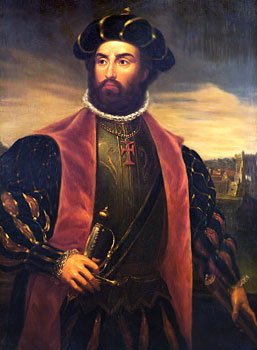 The first contact of the Portuguese with the Malabar Coast was made by the ancient Red Sea route years before Vasco da Gama sailed from Belem. In 1487 Joao II sent one of his noblemen, Joao Peres de Covilhao, on a mission of reconnaissance. Covilhao knew Arabic sufficiently well to pass as a Muslim; in disguise he travelled to Aden, and thence sailed on an Arab ship to the Malabar Coast, where he stayed undetected for several months in Calicut and Kannur (Cannanore). While returning, he came by way of Abyssinia, but there he died before his story could be narrated to the king who had sent him. Nevertheless, the Portuguese moved ahead with their plans for an expedition around the Cape of Good Hope, and in the month of July 1497, Vasco da Gama sailed from Portugal. The following year, he arrived at Calicut via Natal, Mozambique and Mombasa. Initially he was welcomed by the Zamorins of Calicut.
The first contact of the Portuguese with the Malabar Coast was made by the ancient Red Sea route years before Vasco da Gama sailed from Belem. In 1487 Joao II sent one of his noblemen, Joao Peres de Covilhao, on a mission of reconnaissance. Covilhao knew Arabic sufficiently well to pass as a Muslim; in disguise he travelled to Aden, and thence sailed on an Arab ship to the Malabar Coast, where he stayed undetected for several months in Calicut and Kannur (Cannanore). While returning, he came by way of Abyssinia, but there he died before his story could be narrated to the king who had sent him. Nevertheless, the Portuguese moved ahead with their plans for an expedition around the Cape of Good Hope, and in the month of July 1497, Vasco da Gama sailed from Portugal. The following year, he arrived at Calicut via Natal, Mozambique and Mombasa. Initially he was welcomed by the Zamorins of Calicut.
To the Malayalis, the newly-arrived strangers and their strange craft were objects of wonder, but the Arab merchants, who had close trading links with the Mediterranean, were clearly aware of the identity of the newcomers, and when, as they awaited an audience with the Zamorin, the Portuguese tried to open trade, they encountered a disconcerting lack of interest in the goods they offered. Eventually, after a noble delay, the Zamorin welcomed Vasco da Gama in ceremonial durbar, along with his ministers and chieftains. Braving the humid Malabar heat, da Gama dressed intricately in velvet and blue satin, and a brocade-lined cloak of tawny satin; a long beard which he had vowed to cut till he returned to Portugal, presented an impressive appearance. His trumpeters marched before him, and his pages contained the presents he had brought, including a gilded chair on which the Zamorin sat to conduct the audience. There was a theatrical tawdriness regarding the Portuguese procession, in comparison with the curious combination of extreme simplicity of dress and great richness of jewellery which the Zamorin, clad and adorned in the manner of the sovereigns of Kerala, presented to the curious eyes of his visitors.
Among the debts we owe to the Portuguese reaching the Malabar Coast on the early expeditions are such vivid detailed descriptions, the first clear pictures we possess of traditional Keralan life. But for Vasco da Gama the strangeness of his surroundings seems to have been no compensation for the evasiveness of the Zamorin when it came to questions of business. The Portuguese did not receive any clear answer with regard to their trade in Calicut. Thus, the Portuguese became suspicious of Arab intrigues. They even - with no apparent justification - became concerned about their safety and seized five Malayalis as hostages; ignorant of local customs, they made the mistake of picking low-caste fishermen. Lastly, the Zamorin agreed that the Portuguese might leave a factor to look for buyers for their unsold goods; provided they pay the usual customs dues. The proposal was refused by Vasco da Gama, and sailed away with his hostages. This confirmed the Zamorin the warnings received by the Arab merchants regarding the ambitions of the Portuguese and sowed the seeds of future hostility.



















